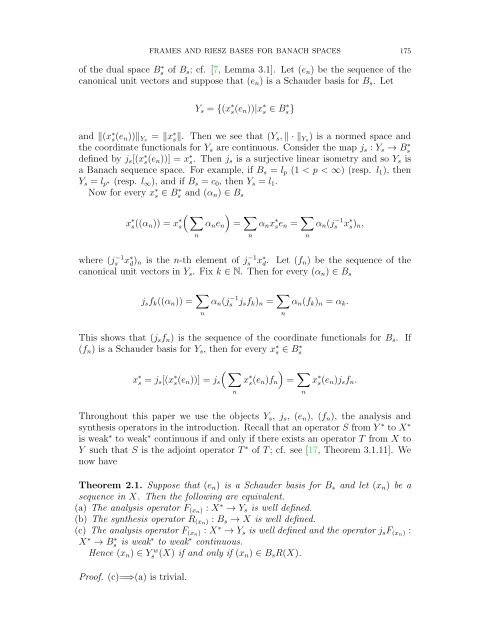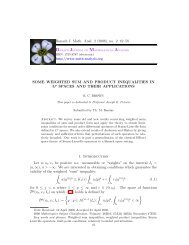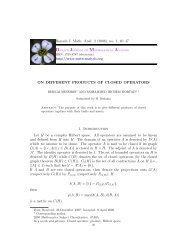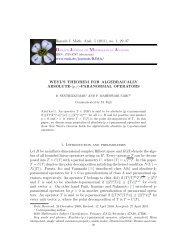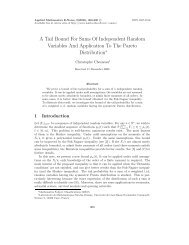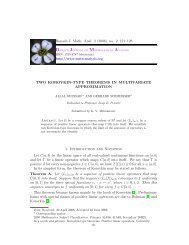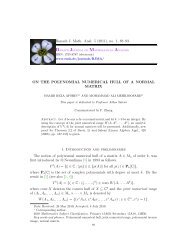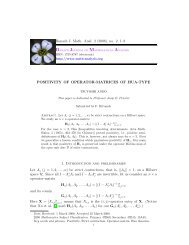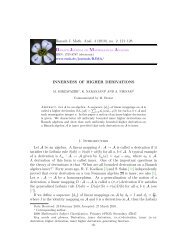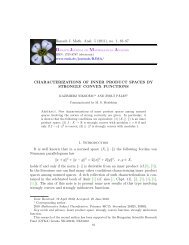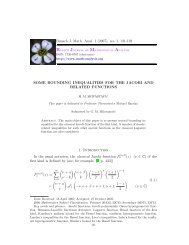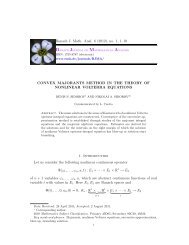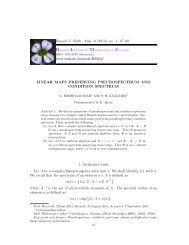Frames and Riesz bases for Banach spaces, and Banach spaces of ...
Frames and Riesz bases for Banach spaces, and Banach spaces of ...
Frames and Riesz bases for Banach spaces, and Banach spaces of ...
- No tags were found...
Create successful ePaper yourself
Turn your PDF publications into a flip-book with our unique Google optimized e-Paper software.
FRAMES AND RIESZ BASES FOR BANACH SPACES 175<strong>of</strong> the dual space B ∗ s <strong>of</strong> B s ; cf. [7, Lemma 3.1]. Let (e n ) be the sequence <strong>of</strong> thecanonical unit vectors <strong>and</strong> suppose that (e n ) is a Schauder basis <strong>for</strong> B s . LetY s = {(x ∗ s(e n ))|x ∗ s ∈ B ∗ s}<strong>and</strong> ‖(x ∗ s(e n ))‖ Ys = ‖x ∗ s‖. Then we see that (Y s , ‖ · ‖ Ys ) is a normed space <strong>and</strong>the coordinate functionals <strong>for</strong> Y s are continuous. Consider the map j s : Y s → Bs∗defined by j s [(x ∗ s(e n ))] = x ∗ s. Then j s is a surjective linear isometry <strong>and</strong> so Y s isa <strong>Banach</strong> sequence space. For example, if B s = l p (1 < p < ∞) (resp. l 1 ), thenY s = l p ∗ (resp. l ∞ ), <strong>and</strong> if B s = c 0 , then Y s = l 1 .Now <strong>for</strong> every x ∗ s ∈ Bs ∗ <strong>and</strong> (α n ) ∈ B s( ∑ )x ∗ s((α n )) = x ∗ s α n e n = ∑nnα n x ∗ se n = ∑ nα n (j −1s x ∗ s) n ,where (js−1 x ∗ d ) n is the n-th element <strong>of</strong> js−1 x ∗ d . Let (f n) be the sequence <strong>of</strong> thecanonical unit vectors in Y s . Fix k ∈ N. Then <strong>for</strong> every (α n ) ∈ B sj s f k ((α n )) = ∑ nα n (js−1 j s f k ) n = ∑ nα n (f k ) n = α k .This shows that (j s f n ) is the sequence <strong>of</strong> the coordinate functionals <strong>for</strong> B s . If(f n ) is a Schauder basis <strong>for</strong> Y s , then <strong>for</strong> every x ∗ s ∈ B ∗ s( ∑ )x ∗ s = j s [(x ∗ s(e n ))] = j s x ∗ s(e n )f n = ∑ nnx ∗ s(e n )j s f n .Throughout this paper we use the objects Y s , j s , (e n ), (f n ), the analysis <strong>and</strong>synthesis operators in the introduction. Recall that an operator S from Y ∗ to X ∗is weak ∗ to weak ∗ continuous if <strong>and</strong> only if there exists an operator T from X toY such that S is the adjoint operator T ∗ <strong>of</strong> T ; cf. see [17, Theorem 3.1.11]. Wenow haveTheorem 2.1. Suppose that (e n ) is a Schauder basis <strong>for</strong> B s <strong>and</strong> let (x n ) be asequence in X. Then the following are equivalent.(a) The analysis operator F (xn) : X ∗ → Y s is well defined.(b) The synthesis operator R (xn) : B s → X is well defined.(c) The analysis operator F (xn) : X ∗ → Y s is well defined <strong>and</strong> the operator j s F (xn) :X ∗ → Bs ∗ is weak ∗ to weak ∗ continuous.Hence (x n ) ∈ Ys w (X) if <strong>and</strong> only if (x n ) ∈ B s R(X).Pro<strong>of</strong>. (c)=⇒(a) is trivial.


